Downloads
Executable for the map editor - exactly the same as in part 40 (Windows 32bits)
Executable for the game (Windows 32bits)
Before you try to compile the code go to the "Projects" tab on the left menu, select the "Run" settings for your kit,
and set the "Working directory" to the path of "editor\data" for the editor or "game\data" for the game.
Damages and death
Now we we will really reduce their life and see how they die.
First we need to complete the hitChampion() function.
void CCharacter::hitChampion(int num, int damages)
{
// TODO: wound, damage types
// already dead or empty ?
if (portrait == -1 || isDead() == true)
return;
displayedDamages = damages;
damagesTimer.set(90, false);
stats[eStatHealth].value -= damages;
static CVec2 championPos[4][4] =
{
{{0, 0}, {1, 0}, {0, 1}, {1, 1}}, // up
{{0, 1}, {0, 0}, {1, 1}, {1, 0}}, // left
{{1, 1}, {0, 1}, {1, 0}, {0, 0}}, // down
{{1, 0}, {1, 1}, {0, 0}, {0, 1}} // right
};
// dead ?
if (stats[eStatHealth].value <= 0)
{
stats[eStatHealth].value = 0;
// drop all objects on the ground
CVec2 stackPos = player.pos * 2 + championPos[player.dir][num];
CObjectStack* stack = map.addObjectsStack(stackPos, eWallSideMax);
for (int i = 0; i < eBodyPartCount; ++i)
{
CObject& obj = bodyObjects[i];
if (obj.getType() != 0)
{
stack->addObject(obj);
obj.setType(0);
}
}
// drop the champion's bones
CObject bones;
bones.setType(OBJECT_TYPE_BONES);
bones.setIntParam("Champion", num);
stack->addObject(bones);
}
}
When he's dead, we drop all of its objects and its bones on the ground.
the championPos table gives us the positions where we drop these items based on the player's direction.
This looks like that:
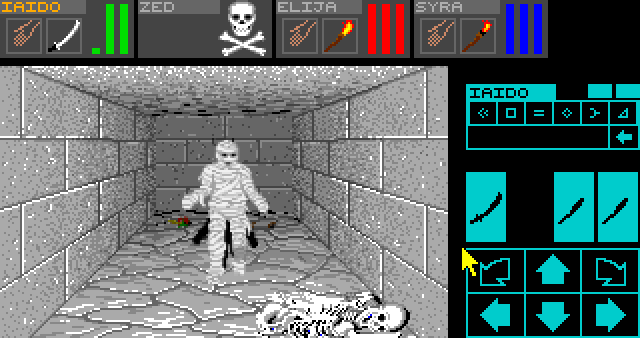
You can see that I added a "Champion" parameter to the bones object.
<!-- # BONES -->
<item name="ITEM149">
[...]
<param type="int">Champion</param>
</item>
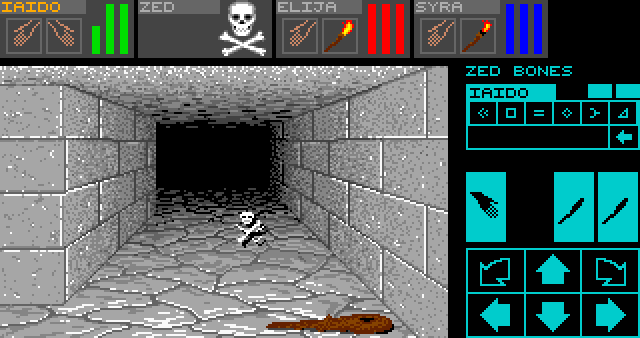
We use the same function we wrote for the messages at the bottom of the screen to insert this name in the string.
void CInterface::drawObjectName(QImage* image)
{
int type = mouse.mObjectInHand.getType();
if (type != 0)
{
std::string name;
if (type == OBJECT_TYPE_BONES)
name = setChampionNameInString(mouse.mObjectInHand.getIntParam("Champion"), "ITEM149");
else
name = objects.mObjectInfos[type].name;
drawText(image, CVec2(233, 33), eFontStandard, name.c_str(), MAIN_INTERFACE_COLOR);
}
}
Hitting the walls
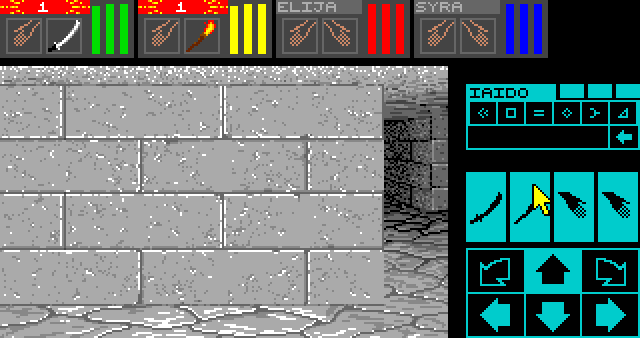
When the party hits a wall, the 2 champions in the front row relatively to the wall take damages.
The value of the damages in the original game were computed with a strange formula based on the champions' stats,
but I replaced it with a simple random value between 1 and 2.
void CPlayer::moveIfPossible(EWallSide side)
{
[...]
if (canMove == true)
{
[...]
}
else
{
if (game.characters[0].portrait != -1)
{
static const int championsHit[eWallSideMax][2] =
{
{0, 1}, // eWallSideUp
{2, 3}, // eWallSideDown
{0, 2}, // eWallSideLeft
{1, 3} // eWallSideRight
};
for (int i = 0; i < 2; ++i)
{
int champNum = championsHit[invWallSide(side)][i];
game.characters[champNum].hitChampion(champNum, (RANDOM(4) == 0 ? 2 : 1));
}
sound->play(newPos, "sound/Party_Damaged.wav");
}
}
}
two players in the front row are dead.
But we will have to rewrite those functions when we add the characters placement inside the party.
Falling into a pit
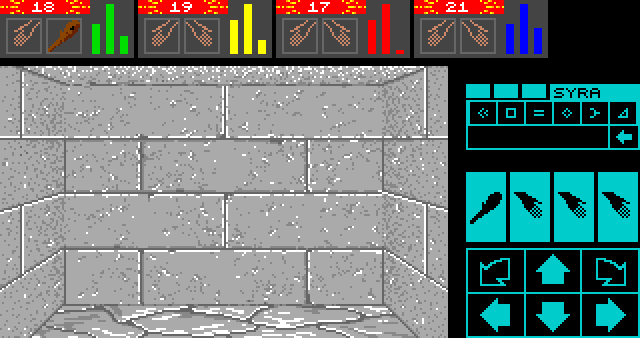
When the party falls into a pit, every champion takes damage.
It's a random value around 20. But this value will change when we add wounds to the characters.
void CPlayer::fall()
{
[...]
hitAllChampions(20);
}
//-----------------------------------------------------------------------------------------
void CPlayer::hitAllChampions(int damages)
{
int rnd = damages / 8 + 1;
sound->play(pos, "sound/Party_Damaged.wav");
for (int i = 0; i < 4; ++i)
{
int dmg = damages - rnd + RANDOM(rnd * 2);
dmg = MAX(1, dmg);
game.characters[i].hitChampion(i, dmg);
}
}
Vi altar
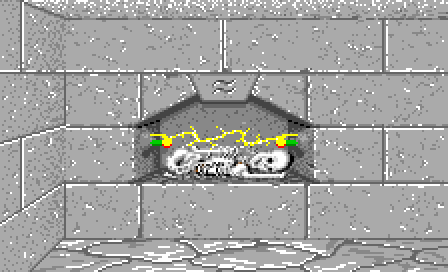
When you put the bones of a champion inside a Vi altar, the resurrection process begins.
We will store the wall's position and side and start a timer.
void CGame::update(SMouseArea* clickedArea)
{
[...]
else if (clickedArea->type == eMouseAreaG_DropObject)
{
// get the pos and side
[...]
// drop object
CObjectStack* stack = map.addObjectsStack(pos, side);
stack->addObject(mouse.mObjectInHand);
// test if we resurrect a champion
if (mouse.mObjectInHand.getType() == OBJECT_TYPE_BONES &&
side != eWallSideMax)
{
CWall& wall = map.getTile(pos)->mWalls[side];
if (wall.getType() == eWallAlcove &&
wall.getEnumParam("Type") == 2)
{
// resurrect
sound->play(pos, "sound/Spell.wav");
walls.resurrectWallPos = pos;
walls.resurrectWallSide = side;
walls.resurrectTimer.set(120, true);
}
}
The graphics of the lightning comes from a "lightning bolt" missile, but we will talk about missiles in another
part.
The animation consists in flipping this lightning image every 1/2 second, and it is displayed as a wall's ornate.
CWalls::COrnateData alcoveLightning =
{
"",
"gfx/3DView/missiles/Lightning_side.png",
"",
{82, 95},
{0, 0}
};
//---------------------------------------------------------------------------------------------
CRect CWalls::drawOrnate(QImage* image, CVec2 tablePos, EWallSide side, int ornate, int textLines)
{
if (ornate != 0)
{
int tableSide = walls.getTableSide(side, false);
if (gWallsInfos[tablePos.y][tablePos.x][tableSide].size.x != 0)
{
COrnateData* ornateData = NULL;
if (ornate == ORNATE_ALCOVE_LIGHTNING)
ornateData = &alcoveLightning;
else
ornateData = &walls.ornatesDatas[ornate];
[...]
// draw the ornate on screen.
bool flipX = false;
bool flipY = false;
if (ornate == ORNATE_ALCOVE_LIGHTNING)
{
int image = walls.resurrectTimer.get() / 30;
flipX = image & 1;
flipY = (image >> 1) & 1;
}
graph2D.drawImage(image, ornatePos, tempImage, 0, flipX, QRect(0, 33, MAINVIEW_WIDTH, MAINVIEW_HEIGHT), flipY);
Explosion
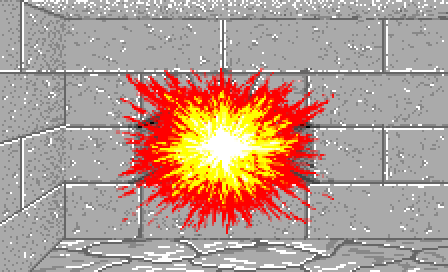
When the lightning animation stops, an explosion appears for a short duration.
I created a new file "explosions.cpp" to handle it because explosions and clouds will be used a lot for spells.
An add() function is called to create a new explosion and add it to a list.
The parameter of this function are the map position, the type of explosion, and its duration.
void CExplosions::add(EExplosions type, CVec2 mapPos, int duration)
{
SExplosion explo;
explo.type = type;
explo.mapPos = mapPos;
explo.timer.set(duration, true);
mExploList.push_back(explo);
if (type == eExplo_Resurrect)
sound->play(mapPos, "sound/Explosion.wav");
}
void CExplosions::update()
{
std::vector<SExplosion>::iterator it = mExploList.begin();
while(it != mExploList.end())
{
if (it->timer.update() == true)
it = mExploList.erase(it);
else
it++;
}
}
void CExplosions::draw(QImage* image, CVec2 mapPos, CVec2 tablePos)
{
for (size_t i = 0; i < mExploList.size(); ++i)
{
SExplosion& explo = mExploList[i];
if (explo.mapPos == mapPos)
{
QImage exploGfx;
CVec2 pos;
float scale = 1.0;
if (explo.type == eExplo_Resurrect)
{
exploGfx = fileCache.getImage("gfx/3DView/explosions/Fireball.png");
pos = CVec2(57, 66);
scale = 110.0 / 145.0;
}
const SWallInfos* tabData = &gWallsInfos[tablePos.y][tablePos.x][eWallSideUp];
if (tabData->size.x != 0)
{
const SWallInfos* refWall = NULL;
refWall = &gWallsInfos[3][2][eWallSideUp];
// calculate the position and scale factor and draw the explosion in a temporary image
scale *= (float)tabData->size.y / 111.0f;
QSize scaledSize = exploGfx.size() * scale;
pos = pos - refWall->pos;
pos.x = pos.x * tabData->size.x / refWall->size.x;
pos.y = pos.y * tabData->size.y / refWall->size.y;
pos += tabData->pos;
QImage tempImage(scaledSize, QImage::Format_ARGB32);
tempImage.fill(TRANSPARENT);
graph2D.drawImageScaled(&tempImage, CVec2(), exploGfx, scale);
// darken the explosion based on it's distance
static const float shadowLevels[] = {0.0f, 0.2f, 0.4f};
float shadow = shadowLevels[WALL_TABLE_HEIGHT - 1 - tablePos.y];
graph2D.darken(&tempImage, shadow);
// draw the explosion on the screen.
graph2D.drawImage(image, pos, tempImage, 0, false, QRect(0, 33, MAINVIEW_WIDTH, MAINVIEW_HEIGHT));
}
}
}
}
void CWalls::update()
{
// vi altar animation
if (resurrectTimer.update() == true)
{
// retrieve champion's number
CObjectStack* stack = map.findObjectsStack(resurrectWallPos, resurrectWallSide);
int last = stack->getSize() - 1;
CObject& bones = stack->getObject(last);
int champNum = bones.getIntParam("Champion");
// delete object
stack->removeObject(last);
resurrectWallSide = eWallSideMax;
// resurrect champion
CCharacter::SStat& health = game.characters[champNum].stats[CCharacter::eStatHealth];
health.value = health.startValue / 2;
// launch explosion
explosions.add(eExplo_Resurrect, player.pos, 20);
}
}
Health regeneration
So, like the mana, I used a timer that is set up with 2 values depending on whether or no we are sleeping.
#define HEALTH_REGEN_TIMER (30 * 60)
#define HEALTH_REGEN_TIMER_SLEEP 90